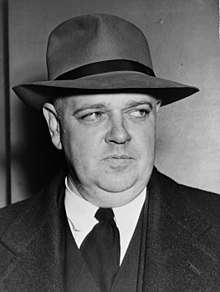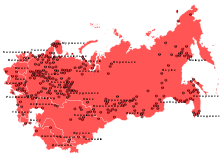Alexander Ulanovsky
Alexander Ulanovsky (1891–1970) was the chief illegal "rezident" for Soviet Military Intelligence (GRU), who was rezident in the United States 1931–1932 with his wife and was imprisoned in the 1950s with his family in the Soviet gulag.
Alexander Ulanovsky | |
|---|---|
.jpg) Alexander Ulanovsky | |
| Born | Izrail Khaykelevich Ulanovsky 1891 |
| Died | 1970 USSR |
| Occupation | Intelligence officer |
| Spouse(s) | Nadezhda Ulanovskaya |
| Children | Maya Ulanovskaya |
| Espionage activity | |
| Allegiance | |
| Service branch | GRU |
| Service years | 1923-1948 |
| Codename | Ulrich |
| Codename | William Joseph Berman |
| Codename | Bill Berman |
| Codename | Felik |
| Codename | Long Man |
| Other work | Alexander Petrovich Ulanovsky |
Early life
Background
Born Izrail Khaykelevich Ulanovsky to a Jewish family in Chişinău, (Bessarabia), he joined the anarchists as a young man. In 1907, his family moved to Kerch (Crimea). Arrested for radical activity, he was deported to Siberia, where he was confined to the same village (Turukhansk) as Joseph Stalin. While in exile, he made a daring escape and "on his way out" entered Stalin's flat and took his fur coat, as was customary among fellow-exiles in such a situation.
Russian Revolution

Following the October Revolution, Ulanovsky returned to Russia and enlisted in the Red Army. He served as the deputy-commander of an armored train (under anarchist revolutionary Anatoli Zhelezniakov) and took part in fighting against White armies in Ukraine and Crimea. After the Russian Civil War, he joined Soviet military intelligence and served as a secret agent in, among other places, Buenos Aires and Shanghai.
Espionage
United States

Together with his wife Nadezhda, Ulanovsky came to America on the maiden voyage of the SS Bremen in 1931. His mission was to take over the GRU (military intelligence) apparatus assembled by his predecessor, Manfred Stern, who was moving on to China. Some of the known members of the group were Lydia Stahl, Robert Gordon Switz, Leon Minster, Robert Osman, Joshua Tamer, and Whittaker Chambers.
In his memoirs, Witness, Chambers provided an insider's view of the workings of the apparatus and a deferential portrait of Ulanovsky, whom he called "the only Russian who was ever to become my close friend." [1]
The spy Hede Massing also knew Ulanovsky at this time under the alias "William Joseph Berman" ("Bill Berman"—also "Felik" and "the Long Man"). In her memoirs, she picked up on his anarchist tendencies without understanding where they came from. Thus, she describes him as a "nice enough man," a "simple man," and "one of the least ambitious and offensive" Russian agents she ever knew, but also "confused and inept." When Massing mentions that Ulanovsky had told her he was not her boss and that they were "both waiting for the boss", she implies that he ranked closely to her. However, Ulanovsky meant not that "the" (their) boss but that "her" boss was coming (Valentin Markin). Despite all this, she notes, "But one thing he did know expertly: This was conspiracy."[2]
The group's principal activity was securing patent applications, blueprints, and technical manuals which they would pack into a large crate and ship to the Soviet Union. Ulanovsky returned to Europe after the failure of several GRU operations, notably a bungled scheme to counterfeit U.S. currency and the arrest of Robert Osman in Panama on espionage charges. An NKVD illegal, Valentin Markin, came to America and took control of GRU operations in 1934.
Europe
Ulanovsky resurfaced in Copenhagen in 1935, operating under the alias Nathan Sherman and acting as the head of a Soviet espionage ring that collected military information on Nazi Germany. The Danish police arrested Ulanovsky and two Americans, Leon Josephson and George Mink, following a search of their hotel room which turned up codes, money, and multiple passports. The motive for the search was a charge of rape against Mink by a chambermaid. Ulanovsky claimed they were Jewish anti-fascists acting on their own, but the police produced information, possibly obtained from the Gestapo, that proved they were working for Soviet intelligence.
The Danes held a secret trial and convicted Ulanovsky of spying and sentenced him to eighteen months in prison. He was later deported to the Soviet Union. (Josephson returned to America and worked as a lawyer representing Socialist clients of the Café Society, owned by his brother Barney Josephson. Mink went to Spain where he served as an NKVD assassin during the Civil War, and then disappeared from the historical record.)
Gulag

Ulanovsky survived the Great Purge. In 1948, his wife Nadezhda was arrested. To no avail, he wrote Stalin a letter recalling their days in Tsarist exile, with assurances that his wife was a loyal Soviet citizen. He was arrested in 1949 as a former anarchist and sentenced to 10 years of hard labor in the Gulag. In 1951, their daughter Maya Ulanovskaya was arrested and the next year imprisoned. They were released under Nikita Khrushchev. In the 1960s they were close to dissident circles in Moscow. Maya married literary critic and dissident Anatoly Yakobson.
Personal life and death

By 1922, Ulanovsky married Esther Markova Fridgant (Party name Nadezhda Ulanovskaya). They had a son and a daughter named Maya Ulanovskaya. In 1970, Ulanovsky died in the Soviet Union. In 1983, wife Nadezhda, daughter Maya, son-in-law Anatoly Yakobson, and grandson Alexander Yakobson emigrated to Israel.
See also
References
- Chambers, Whittaker (1952). Witness. Random House. pp. 290–300 and others. ISBN 0-89526-571-0.
- Massing, Hede (1951). This Deception. New York: Duell, Sloan and Pearce. pp. 143–145 (description), 147–148, 158, 162. LCCN 51002483.
External sources
- Chambers, Whittaker (1952). Witness. Random House. ISBN 0-89526-571-0.
- Hede Massing, This Deception, Duell, Sloan, and Pearce, 1951.
- Sam Tanenhaus, Whittaker Chambers, Random House, 1997.
- Maya and Nadezhda Ulanovskaya, Istoriya Odnoi Semyi (One Family's Story), Chalidze Publications, 1982.
- Louis Waldman, Labor Lawyer, E.P. Dutton, 1944.
- Weinstein, Allen (1978). Perjury: The Hiss–Chambers Case. New York: Ballantine Books. LCCN 77075009.
- Улановские Надежда и Майя: История одной семьи. С.-Петербург : Инапресс, 2005.